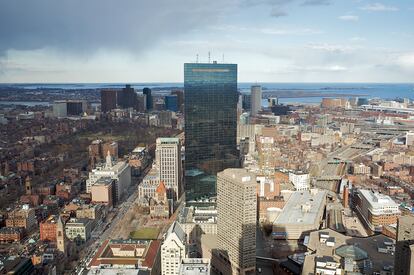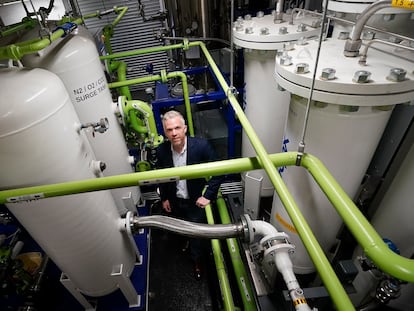Fazlur Khan, the man who saved all the skyscrapers in the world with bamboo cane
Thanks to the economical tubular structure system devised by the Bangladeshi-American engineer in 1962, skyscrapers such as the Twin Towers or the Citigroup Center were built, while the John Hancock Tower was rescued from sinking

In 1965, the famous psychic Jeane Dixon predicted that what is today known as the John Hancock Center in Chicago was going to collapse. A year later, the construction engineer responsible for the project received a terrifying call: “The building is sinking into the ground.” A race began to save not only that skyscraper, but all the skyscrapers in the world. A race that – without anyone noticing – had actually already begun three years earlier.
In 1962, architect Bruce Graham – from the firm Skidmore, Owings & Merrill (SOM) – asked engineer Fazlur Rahman Khan to tell him which was the most economical structure possible to build a skyscraper. The question was a question of survival because, at that time, the world of architecture was wondering if skyscrapers had stopped making sense. A mid-rise tower was still being built here and there, but superskyscrapers – such as the Empire State Building – seemed to be a thing of the past. They were simply too expensive to build.
So, when Bruce Graham was commissioned to build a residential tower in Chicago, he asked his engineer to design the cheapest possible structure. Khan, however, didn’t answer immediately. He told Graham to wait… and went down to a flower shop.
Fazlur Khan – who was only 33-years-old at the time – was a kind of entertainer: a talkative and charming guy who liked to tell jokes and do magic tricks. He returned from the flower shop and – like a magician in a theater – showed Graham what he had bought: a bamboo stick. “This is the most economical and most efficient structure for building a skyscraper.”

The tallest building that Bangladesh-born Khan had seen during his childhood was three or four stories high. In fact, he didn’t see a skyscraper until he emigrated to Chicago in 1950, when he was 21-years-old. However, when his architect colleague asked him for the most effective structure possible, Khan remembered the forests around his home in Bangladesh: he recalled how he had marveled at the resistance of a plant as light as bamboo.
He was absolutely right. The best structure for a skyscraper wasn’t the typical framework of steel beams and pillars. Rather, it was a tube – like a bamboo stick. How come? Well, for two essential reasons. On the one hand, it’s the structure that best resists wind (wind being the number one enemy of a skyscraper). And, on the other hand, by placing the support structure on the façade, the pillar floors are freed up, resulting in more and better-distributed surface area. This, in turn, leads to more units… and more profit.
Using the tubular frame system, Graham and Khan built the DeWitt-Chesnut Apartment Building in Chicago. Inaugurated in 1965, it’s a very elegant building with 42 floors. It offered the men training for the assignment that would change their lives.
In 1964, developer Jerry Wolman – then-owner of the Philadelphia Eagles – commissioned them to build a superskyscraper on Chicago’s Magnificent Mile. Wolman wanted a monumental tower – the tallest building in Chicago – which would reach at least 90 floors. But there was a condition imposed by the John Hancock Life Insurance Company, the firm that was financing Wolman’s project: it had to cost less than $100 million (about $970 million in today’s money).
At first glance, this may seem like a huge sum. Although, if we recall that the Twin Towers cost about $200 million each – or about $3.8 billion total in today’s money – in reality, the undertaking seemed impossible. Unless, of course, you were Fazlur Khan.
When the dilemma was raised in the office, Graham asked the Bangladeshi-American engineer again: “Could a 90-story building be built with $100 million?”
“No,” Khan replied. “With $100 million, we can build a 100-story skyscraper.”

In reality, with the conventional exterior tube system, it was very difficult to achieve what Khan promised… but he had an ace up his sleeve. The amount of materials utilized in the façade could be reduced, so long as the entire façade was also acting as a support structure. Thanks to a system of diagonals that he designed with one of his students from the Illinois Institute of Technology, Khan transformed the facade of the future skyscraper into a kind of superbeam – a supertruss that distributed all the force of the wind across the facade. What’s more, to ensure that the system was as efficient as possible, Khan turned to two young computer engineers, who calculated the entire structure using the nascent computers of the time. An iconic design was born.
With that design, Khan and Graham assured Wolman that the tower would measure 100 stories and cost $100 million. The project was approved and appeared in all the newspapers and all the architectural magazines. The future Wolman Building was going to be the second-tallest building in the world (behind the Empire State Building) and was practically double the height of the tallest building in Chicago. The windy city would, once again, be the city of skyscrapers.
But, like the wind, destiny is sometimes treacherous. In December of 1965, the famous psychic Jeane Dixon wrote an ominous prophecy in her column for Parade Magazine: “The new 100-story skyscraper [that’s under] construction in Chicago is going to collapse before the work is completed.” The prediction wouldn’t have gone beyond gossip in the society pages… if it weren’t for the fact that Dixon was, actually, quite famous. She was a big name because, in 1956, she had predicted the assassination of President John F. Kennedy, which occurred seven years later.
The work continued, but some of the bricklayers and workers suddenly jumped at any strange noise. And then, in July of 1966 – when 20 floors of the skyscraper had already been built – Khan received a terrifying call: “The tower is sinking into the ground.”

Khan stopped the work immediately and went to the site to find out what was happening. Indeed, the building was sinking too much. They had planned for the foundation to settle when the tower was finished, after a drop of about three feet… but it had already dropped by three feet with only 20 floors complete.
What had happened? How was it possible that Khan and the computer engineers had made such a mistake in their calculations? Well, what had happened was something that had happened many times before (and would happen many times after): the construction company, wanting to save money, had unknowingly caused an incipient catastrophe.
The problem was that the soil in Chicago is very soft and very muddy. It’ss essentially identical to the bed of Lake Michigan. Hence, the foundations Khan designed were similar to those used in the pylons of bridges that cross rivers. This type of foundation – called a “foundation pit” – works through a system that sinks very slowly and deliberately as it’s built. It’s very effective for these soils… but it has to be done carefully. The builder working on Khan’s design hadn’t been cautious.
Through a series of ultrasonic tests, Khan discovered that the construction workers had been pouring concrete while the drills were still inside the wells, disrupting the setting process. This was even more dangerous, because not only had the foundation pit sunk too much – it had also tilted an inch away from its vertical axis. Extrapolated to all 1,128 feet of the skyscraper, this would cause an unacceptable deformation.
Although the mistake wasn’t his and had nothing to do with the diagonal tube system he had designed, Khan’s reputation was at stake, because if the building didn’t reach completion, he wouldn’t be able to demonstrate that his structure was the most effective one available. So, he stopped everything for six months, until the wells settled. The tilted foundation pit was then rebalanced and – with the new calculations – Khan ordered work to resume, ensuring that there would be no further problems.

In the end, Wolman couldn’t make his loan payments, at which point the financier – the John Hancock Life Insurance Company – took ownership of the building, retaining both the architect and the engineer. This is how the financial company ended up getting its name on the skyscraper: the John Hancock Center.
Inaugurated in 1969 and – despite delays – at a cost of just $100 million, the John Hancock Center marked the coronation of Fazlur Khan as an engineer. It also marked a paradigm shift in structural engineering around the world. Starting with the Chicago project, superskyscrapers were, once again, an object of desire. In fact, most were (and continue to be) built using some variation of Khan’s structural system. This is how the Twin Towers, the Citigroup Center and even the brand new ultra-skyscraper at 432 Park Avenue were built.
Fazlur Rahman Khan died in 1982 of a heart attack. He was only 52-years-old. When he died, he was still the engineer of the world’s tallest building: the Sears Tower, also in Chicago (now renamed the Willis Tower). On one of the floors of the tower, there’s a small bas-relief dedicated to Khan, which reads: “One of the greatest structural engineers of our time.” But he was far more than that: Khan was the man who saved all the skyscrapers in the world.
Sign up for our weekly newsletter to get more English-language news coverage from EL PAÍS USA Edition
Tu suscripción se está usando en otro dispositivo
¿Quieres añadir otro usuario a tu suscripción?
Si continúas leyendo en este dispositivo, no se podrá leer en el otro.
FlechaTu suscripción se está usando en otro dispositivo y solo puedes acceder a EL PAÍS desde un dispositivo a la vez.
Si quieres compartir tu cuenta, cambia tu suscripción a la modalidad Premium, así podrás añadir otro usuario. Cada uno accederá con su propia cuenta de email, lo que os permitirá personalizar vuestra experiencia en EL PAÍS.
¿Tienes una suscripción de empresa? Accede aquí para contratar más cuentas.
En el caso de no saber quién está usando tu cuenta, te recomendamos cambiar tu contraseña aquí.
Si decides continuar compartiendo tu cuenta, este mensaje se mostrará en tu dispositivo y en el de la otra persona que está usando tu cuenta de forma indefinida, afectando a tu experiencia de lectura. Puedes consultar aquí los términos y condiciones de la suscripción digital.
More information
Últimas noticias
Most viewed
- Sinaloa Cartel war is taking its toll on Los Chapitos
- Oona Chaplin: ‘I told James Cameron that I was living in a treehouse and starting a permaculture project with a friend’
- Reinhard Genzel, Nobel laureate in physics: ‘One-minute videos will never give you the truth’
- Why the price of coffee has skyrocketed: from Brazilian plantations to specialty coffee houses
- Silver prices are going crazy: This is what’s fueling the rally











































